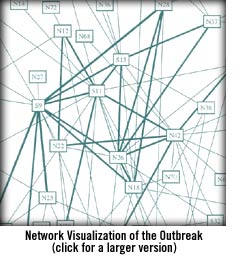 |  | 
[Ed Note: Since this article appeared, final data indicates the total
number of young people exposed in the 1996 syphilis outbreak was more than
200.]


A small cluster of people with syphilis was first detected in the spring of
1996 by a nurse who staffs a part-time STD clinic in a suburban county that is
part of the Atlanta metropolitan area. The nurse reported these cases to the
regional public health office staff that provides disease investigation
services for the county and to the Georgia Division of Public Health. Initial
assessment suggested that the outbreak involved a substantial number of people,
with groups of people who interacted sexually on a regular basis. Additional
help for disease investigation was mobilized from a larger nearby county STD
control program. At the onset, an attempt was made to take a network-oriented
approach to the outbreak by interviewing as many people as possible who might
be involved in transmission (whether infected or not), and by attempting to
record information on standard epidemiologic forms (Centers for Disease Control
and Prevention [CDC] 73.54) for use in network analysis. This report
summarizes information on 99 people and 10 cases of syphilis, and presents an
ethnographic assessment based on follow-up interviews with key participants.


Overall Ethnographic Assessment
 Syphilis was diagnosed in six white female subjects (four of whom were younger
than 16 years of age), two white male subjects (both 17 years of age), and two
African-American male subjects (ages 19 and 16 years). Based on routine
contact interviewing and investigation of infected and uninfected people, and
special ethnographic interviews with key participants, a complex picture of
sexual interaction, starting at least 1 year before the diagnosis of the first
syphilis cases, emerged. At the center of this outbreak was a group of young
white girls (two thirds of whom were 16 years of age or younger) who, in
various combinations, met periodically to use drugs and have a variety of
sexual interactions with several groups of slightly older boys. The venue was
usually the home of one of the girls whose parents were out for the evening.
The two major groups of boys differed in their ethnic and economic background.
One group was a more affluent set of whites 17 to 21 years of age; the other
was a predominantly African-American group of similar age but of less affluent
background. The two groups did not commingle at the parties. The drugs of
choice were blunts (short, mild cigars), to which marijuana or cocaine had been
added, and alcohol. Multiple accounts corroborated the fact that injectable
drugs were not used. Sex was usually public and communal; the girls would have
sequential and simultaneous sex partners, experiencing vaginal, anal, and oral
sex, occasionally at the same time, and occasionally with more than one partner
at a particular orifice. The girls also had sex with each other, and numerous
sexual encounters outside the party environment were also documented. During
the initial outbreak investigation, we were unable to document the extent of
parents' knowledge or understanding (or possible participation) in these
activities.
Syphilis was diagnosed in six white female subjects (four of whom were younger
than 16 years of age), two white male subjects (both 17 years of age), and two
African-American male subjects (ages 19 and 16 years). Based on routine
contact interviewing and investigation of infected and uninfected people, and
special ethnographic interviews with key participants, a complex picture of
sexual interaction, starting at least 1 year before the diagnosis of the first
syphilis cases, emerged. At the center of this outbreak was a group of young
white girls (two thirds of whom were 16 years of age or younger) who, in
various combinations, met periodically to use drugs and have a variety of
sexual interactions with several groups of slightly older boys. The venue was
usually the home of one of the girls whose parents were out for the evening.
The two major groups of boys differed in their ethnic and economic background.
One group was a more affluent set of whites 17 to 21 years of age; the other
was a predominantly African-American group of similar age but of less affluent
background. The two groups did not commingle at the parties. The drugs of
choice were blunts (short, mild cigars), to which marijuana or cocaine had been
added, and alcohol. Multiple accounts corroborated the fact that injectable
drugs were not used. Sex was usually public and communal; the girls would have
sequential and simultaneous sex partners, experiencing vaginal, anal, and oral
sex, occasionally at the same time, and occasionally with more than one partner
at a particular orifice. The girls also had sex with each other, and numerous
sexual encounters outside the party environment were also documented. During
the initial outbreak investigation, we were unable to document the extent of
parents' knowledge or understanding (or possible participation) in these
activities.

Network Visualization
The intensity of interaction between the African-American men and the white
girls was greater than that between the white men and white girls, although
this intensity did not appear to lead to greater transmission
to the African-American men. Visualization of these groups and all their sex
partners uncovered the importance of several people not specifically identified
with these groups (e.g. N43 and S30) who served as bridges between the two
groups of men.

Ethnographic Follow-up
Follow-up interviews, focusing on the current situation and network changes,
were conducted between 6 and 12 months after the initial interviews with a
subsample of eight of the adolescent women. The interviews were held outside
the clinic setting, and subjects voluntarily participated in the 30- to
60-minute session with one of us (C.S.).
Based on their personal history and their comments about others', these young
women revealed that many had continued to be sexually active with multiple
partners in the context of drug and alcohol use. There were, however, some
important changes. A few young women no longer participated because they had
moved or because of stricter parental supervision. In the past, gatherings had
tended to be at the home of one of the young women, but had moved to local
motel and hotel rooms. The originally identified social network had fragmented
into several smaller groups. For example, one of the African-American men who
was central in the original network was apparently no longer willing to engage
in group sex and tended to consort with a single (changeable) partner at a
time. Several woman also claimed to demur from group sex, although group use
of alcohol and drugs had continued for them. Two women stated that they would
"get high" with the group and have sex with one of the male partners, either in
their car or in a hidden public setting. Other women stated that they were in
a steady sexual relationship with a man from the original group involved in the
outbreak. One of the main motivations for sexual risk reduction was the
unconfirmed rumor that one of the men in the central group had been identified
as HIV positive. The women interviewed all appeared to agree that most parents
had not taken action in response to the outbreak, nor were there increased
levels of communication at home regarding drug use and sexual activity.
Thus, the ethnographic data indicate that some social network changes had
occurred that might inhibit continued disease transmission (e.g. fewer sexual
exposures in groups.)The clinic staff indicated that they maintained more
contact with the men than with the women, many of whom began attending the
family planning clinic. Two women in the original cluster of 18 were pregnant
at the time of their treatment for syphilis. Clinic record and verbal reports
indicated that an additional 13 women, 8 from the original cluster and 5 others
involved in the outbreak, became pregnant subsequent to the completion of their
treatment.

home |
discussion |
is this story isolated? |
interviews |
the syphilis outbreak
more about rockdale county |
resources for teens and parents
tapes & transcripts |
synopsis |
press
FRONTLINE |
pbs online |
wgbh
New Content Copyright © 1999 PBS Online and WGBH/FRONTLINE
|